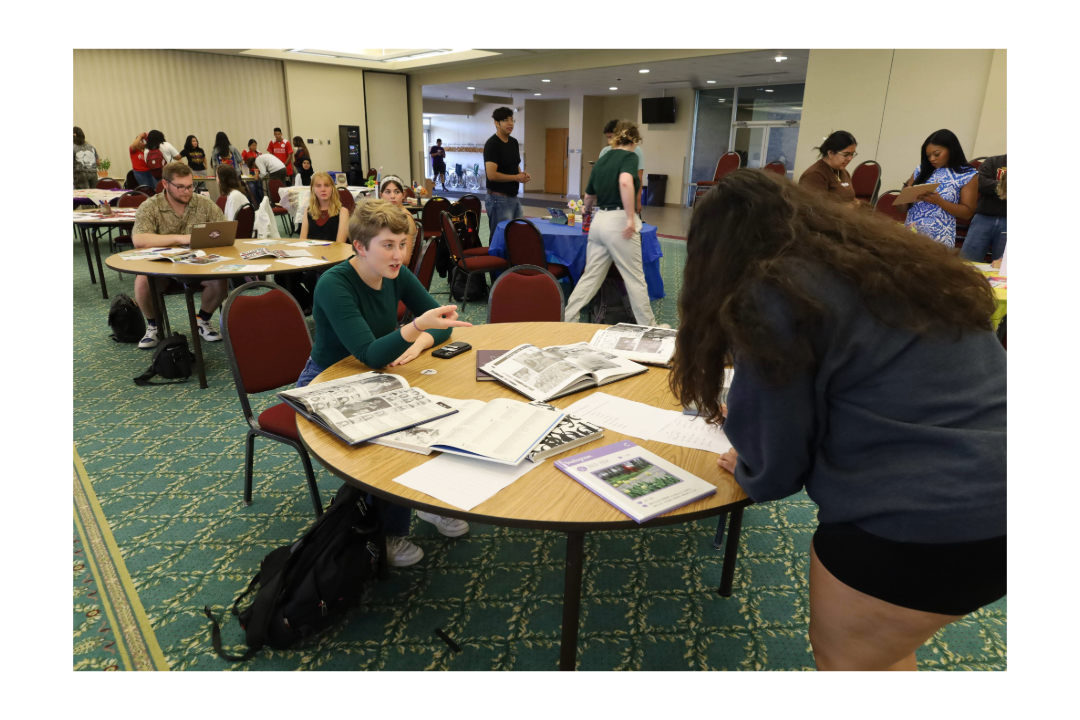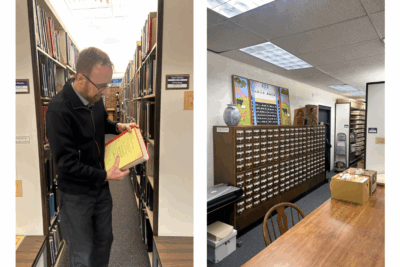Up three flights of stairs, tucked into the shelves of the Mennonite Historical Library, is the collection of Maple Leaf Yearbooks. They span the years from 1916 all the way through 2014, when their time came to an end. Cloth-bound and hardcover, they are surrounded by other historical records of Goshen College: Alumni Newsletters, GC Bulletins, The Record and more. They tell the story of the college.
The Maple Leaf, for its part, portrays the spirit and liveliness of students over the years. From literary society portraits to satirical dictionaries filled with inside jokes, the old yearbooks give insight into the heartbeat of the student body.Eric Bradley, head librarian of the Mennonite Historical Library, uses the yearbook as a resource when people want to know especially about the earlier history of GC. He said, “The two places I always go are The Goshen College Record and The Maple Leaf.”
Bradley referenced a specific instance in which someone came in looking for information about his grandfather, who had at one time long ago been a president and professor of GC. There was not much in the way of letters or other writings to show what sort of a man he had been; instead, the best look came from the dedication at the beginning of an issue of the Maple Leaf, which served better than anything to show that the students really cared about him.
Indeed, the Maple Leaf is an effective catalogue of the students from that period of time lasting nearly a century. However, that catalogue has since been rendered incomplete after the yearbook released its final issue in 2014. According to Bradley, “The quality of the yearbook was less than superior the last few years.”
Social media may have played a sizeable role in the situation as well. Around that time was when some of the platforms we know now were on the rise. Bradley said, “Particularly in the early 2000s, MySpace and of course Facebook, where that kind of served as the yearbook in a sense.”
Many might argue that social media platforms function as well as anything when it comes to keeping track of history now. But the abundance of access to everything can instead mean that there is no centralized area to find historically relevant photographs and stories. Bradley said, “Unfortunately, in terms of us being able to tell the Goshen College story, we don’t have this nice documented yearly piece of students’ compiled material.”
Although classes in the years since 2014 will never be recorded in a collection such as that, there is a fresh chance for the students of today.
Kate Bodiker, a senior double major in writing and communication, is leading an effort to bring back the yearbooks. Though still in its early stages, the yearbook group that Bodiker is heading has applied as a club on campus, and as such can receive student senate funding for the project. Bodiker said, “We’re also hoping to use that in the end toward printing to help keep costs down for students.”
Various details, such as whether or not to use hardcover for the new yearbooks, have an effect on the pricing. Bodiker said, “We’re going to attempt to keep the yearbook prices under thirty dollars. That is our goal.”
Bodiker’s reasons for wanting to revive The Maple Leaf yearbook were also related to maintaining that record of the students over the years. She said, “My parents were GC grads, and I very distinctly remember them showing me, even as a little kid, their yearbooks and being like: ‘these were my best friends. And look at this cool stuff we did.’”
Bodiker affirmed that the yearbook is genuinely a resource that “doesn’t just go dusty on the shelf.” She described having heard a great deal of positive feedback to the idea of bringing this yearbook back, with hopes of continuing it indefinitely.
Perhaps social media is still a prominent competitor against something like the yearbook project, but perhaps not. Bodiker said, “I think people of our generation are having a sort of return to physical media. I feel like that’s something I’ve observed.”




